Birds, with their keen eyes and vibrant worlds, are sometimes mysteriously attracted to gleaming objects. This allure for the shiny and reflective can be both intriguing and, at times, problematic for our avian friends.
But which birds are particularly drawn to shimmering items, and why?
Key Takeaways
Some bird species have a natural inclination towards collecting shiny items.
The attraction to shiny objects is innate rather than learned through experience.
Understanding bird behavior is essential to appreciate their attraction to shiny objects.
Birds Attracted to Shiny Objects
Blue Jay
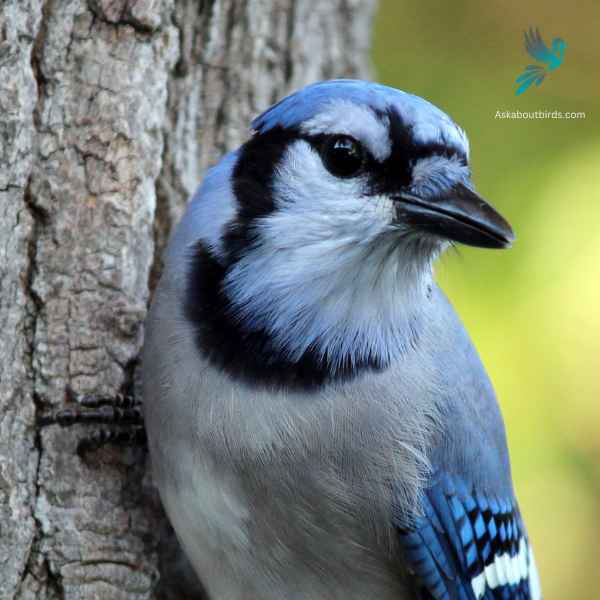
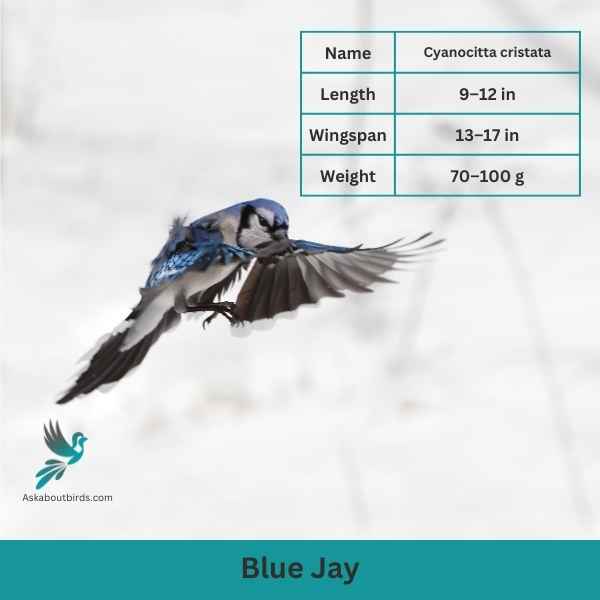
| Feature | Measurement |
|---|---|
| Scientific Name | Cyanocitta cristata |
| Length | 9–12 in |
| Wingspan | 13–17 in |
| Weight | 70–100 g |
The Blue Jay is a vibrant and easily recognized bird, known for its intelligence, distinctive calls, and bold behavior, commonly found throughout the eastern and central United States.
Appearance: The Blue Jay sports a striking blue upper body with white and black markings. Its face has a pronounced white patch with a black necklace that runs across the throat and around the head. The bird also features a pronounced blue crest, which can be raised or lowered, and its wings and tail are brightly colored with black bars and white tips.
Diet: Blue Jays are omnivores. Their diet consists primarily of seeds, nuts, especially acorns, fruits, and small insects. They’ve also been known to eat eggs or nestlings of other birds occasionally. Blue Jays often store food items in caches to eat later.
Reproduction: Blue Jays are monogamous birds that form long-lasting pair bonds. They typically build their nests in trees or large shrubs, constructing them from twigs, grass, and sometimes using mud as a binder. The female lays a clutch of 3 to 6 eggs, which are pale blue or sometimes white with brown speckles.
Crow


| Feature | Measurement |
|---|---|
| Scientific Name | Corvus brachyrhynchos |
| Length | 16–21 in |
| Wingspan | 33–39 in |
| Weight | 11–21 ounces |
The crow is a common bird found in many parts of the world, known for its distinctive black feathers and cawing call. They are highly intelligent and adaptable, able to thrive in a variety of environments from urban areas to rural forests.
Crows are omnivorous, feeding on a range of foods including insects, small animals, seeds, fruit, and carrion. They are also known to scavenge and steal food from other animals, and have been observed using tools to obtain food.
Crows are known for their intelligence and social behaviors, often forming large flocks and working together to defend their territory or find food. They are also known for their ability to recognize individual humans and remember faces, which has led to them being used in research on animal cognition.
Black-Billed Magpie


| Feature | Measurement |
|---|---|
| Scientific Name | Pica hudsonia |
| Length | 13.4-15.4 in |
| Wingspan | 27.5-35.4 in |
| Weight | 220-270 g |
The Black-Billed Magpie is a striking bird native to the western half of North America, recognized for its bold black and white plumage and long tail. Its vocalizations are varied, including harsh chatters and melodious notes, and it’s known to be both curious and intelligent.
Appearance: The Black-Billed Magpie has a unique appearance with its glossy black head, chest, and tail contrasting sharply against its white belly and shoulder patches. Its long tail, which is iridescent greenish-blue, is one of its most distinguishing features. The wings also display a hint of iridescent blue-green.
Diet: Black-Billed Magpies are omnivorous and have a diverse diet. They primarily eat insects, especially in summer, but will also consume small mammals, berries, seeds, and carrion. They are often seen scavenging roadkill and are known to store food in the ground for later consumption.
Reproduction: Black-Billed Magpies mate monogamously and usually build large, domed nests in trees or large shrubs. These nests are made from twigs and mud and can be quite elaborate. The female lays a clutch of about 6 to 9 eggs, which are greenish or bluish and speckled with brown.
Mynah
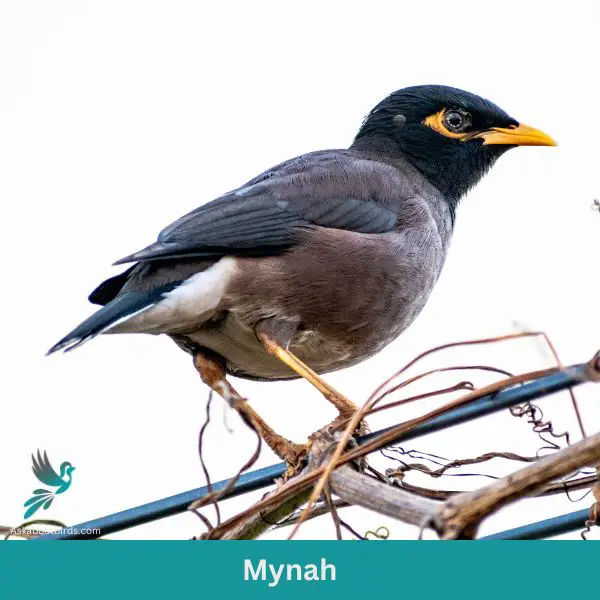

| Attribute | Information |
|---|---|
| Scientific Name | Acridotheres tristis |
| Length | 9-11 inches |
| Wingspan | 18-22 inches |
| Weight | 3.5-5.5 ounces |
The Mynah bird is best known for its exceptional ability to mimic sounds, making it one of the most captivating songbirds in urban areas across its range.
Appearance: Mynahs possess a sleek black body, highlighted by bright yellow patches around the eyes and legs. Their wings often have white markings, especially noticeable during flight.
Diet: Mynahs are omnivorous birds with a penchant for fruits, especially berries. They also consume insects, nectar, and kitchen scraps when in urban settings.
Reproduction: Mynahs prefer to nest in tree hollows, crevices, or other sheltered spots. Once the ideal location is chosen, the female lays a clutch of 2 to 5 eggs.
Western Jackdaw
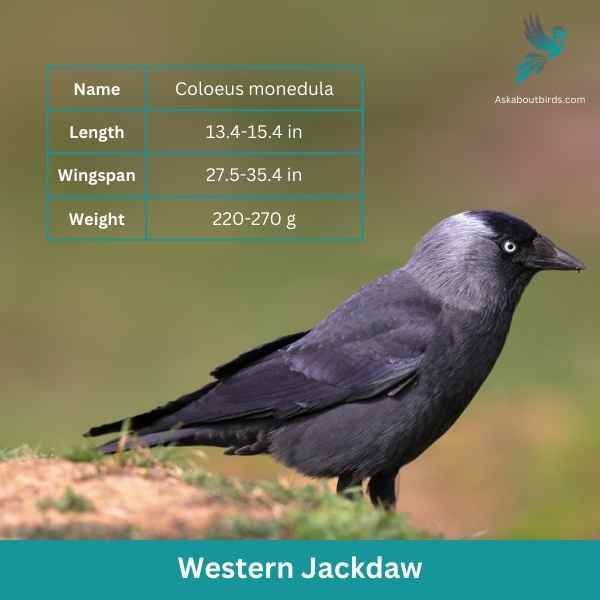
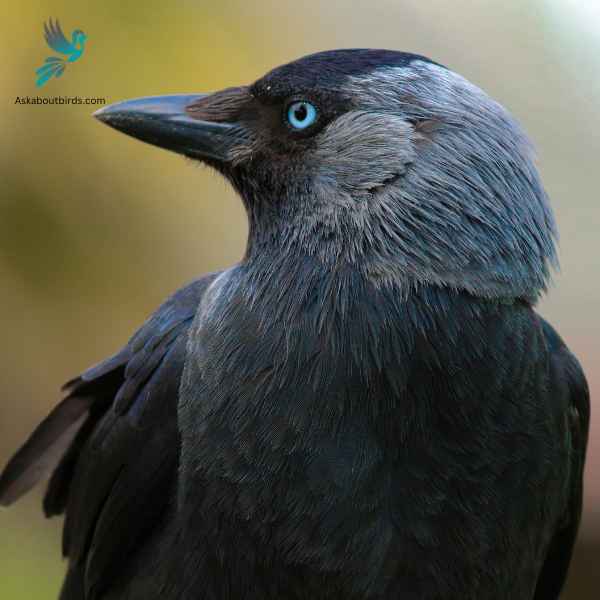
| Feature | Measurement |
|---|---|
| Scientific Name | Coloeus monedula |
| Length | 13.4-15.4 in |
| Wingspan | 27.5-35.4 in |
| Weight | 220-270 g |
The Western Jackdaw is a sociable and intelligent bird, widely recognized for its playful nature and strong affiliation with urban environments.
Appearance: Western Jackdaws are relatively small, with a glossy black plumage that adorns most of their body. However, the sides of their head and nape are light grey. Their striking pale eyes are another distinguishing feature.
Diet: Primarily omnivorous, Western Jackdaws feed on a wide range of items. They prefer seeds, fruits, and insects, but their adaptable nature means they often scavenge for scraps in urban settings, including leftover human foods.
Reproduction: Western Jackdaws are monogamous, often forming bonds that last a lifetime. They prefer to nest in cavities, be it natural ones in trees or man-made structures like chimneys. The female typically lays a clutch of 4 to 6 eggs, which both parents help incubate and raise.
/Burrowing Owl
Satin Bowerbird
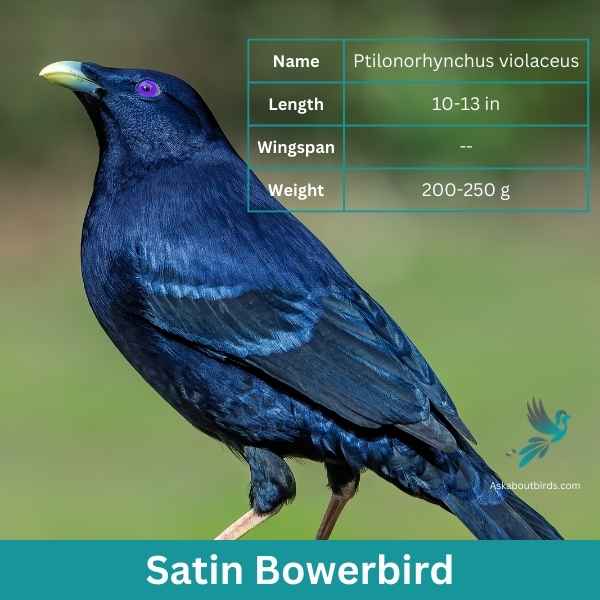
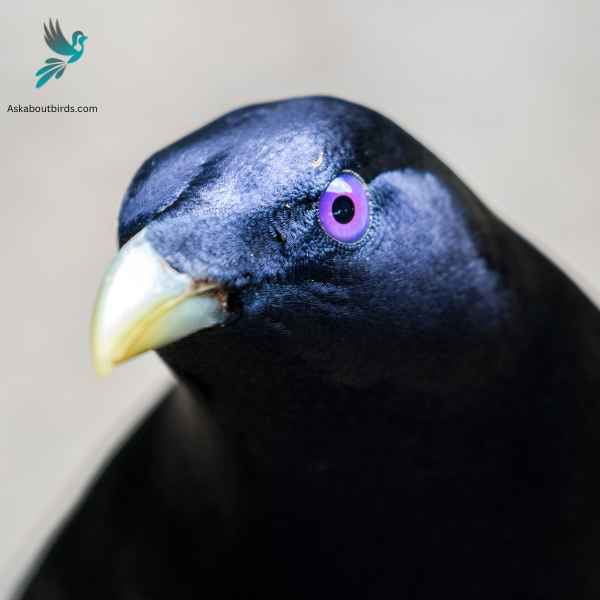
| Feature | Measurement |
|---|---|
| Scientific Name | Ptilonorhynchus violaceus |
| Length | 10-13 in |
| Wingspan | 20-24 inches |
| Weight | 6.0-8.8 ounces |
The Satin Bowerbird is a unique bird recognized for its vibrant blue eyes and the male’s practice of building intricate, decorated bowers to impress potential mates.
Appearance: Satin Bowerbirds have sexual dimorphism in their plumage. Males are glossy blue-black all over, with striking bright blue eyes. Females, on the other hand, are more subdued in coloration with a mix of green, gray, and cream, but they also boast the same vivid blue eyes.
Diet: Satin Bowerbirds have a varied diet but primarily feed on fruits, especially figs. They also consume leaves, seeds, flowers, and insects. Their diet might change based on season and availability of food sources.
Reproduction: Males are known to build specialized structures, or “bowers”, made of twigs and decorated with a collection of blue objects to attract females. These can range from feathers to berries and even man-made items like plastic or bottle caps. After a successful courtship, females lay a clutch of 1 to 3 eggs in a different location, and they are solely responsible for the incubation and rearing of the chicks.
Common Raven

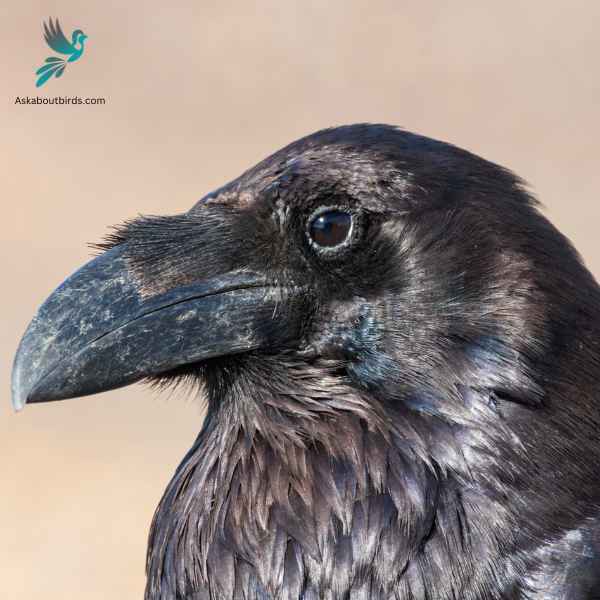
| Feature | Measurement |
|---|---|
| Scientific Name | Corvus corax |
| Length | 21.3-26.4 in |
| Wingspan | 45-51 in |
| Weight | 0.69 to 2 kgs |
The Common Raven is a large, intelligent bird known for its glossy black plumage and its deep, resonating calls. It has a wide distribution and is often associated with myths and legends in various cultures due to its enigmatic nature.
Appearance: Common Ravens are entirely black, from their robust bills to their shaggy throat feathers. Their eyes are dark, and their wingspan is impressive, often mistaken for a hawk or crow. Both males and females share this appearance, though males are typically slightly larger.
Diet: These birds are highly versatile in their diet, feeding on a variety of foods including small mammals, birds, carrion, fruits, grains, and insects. Their adaptability allows them to exploit various food sources depending on availability.
Reproduction: Common Ravens are monogamous and often form long-lasting pair bonds. They typically build large nests made of sticks, often positioned on cliff ledges or high in trees. The female lays a clutch of about 3 to 7 eggs.
Superb Lyrebird
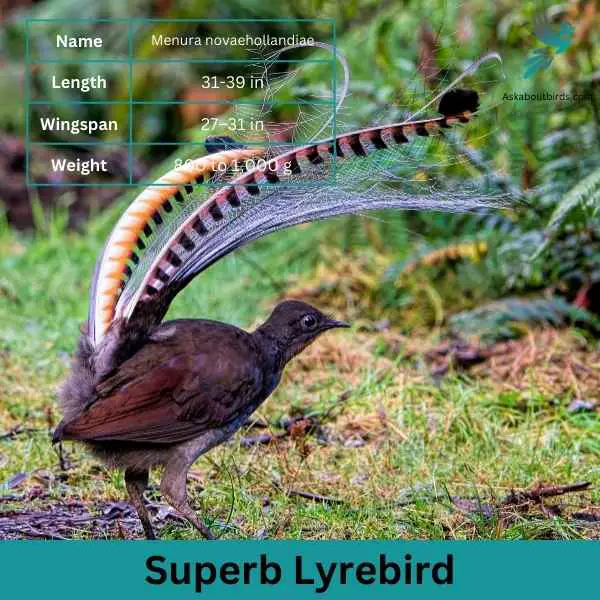
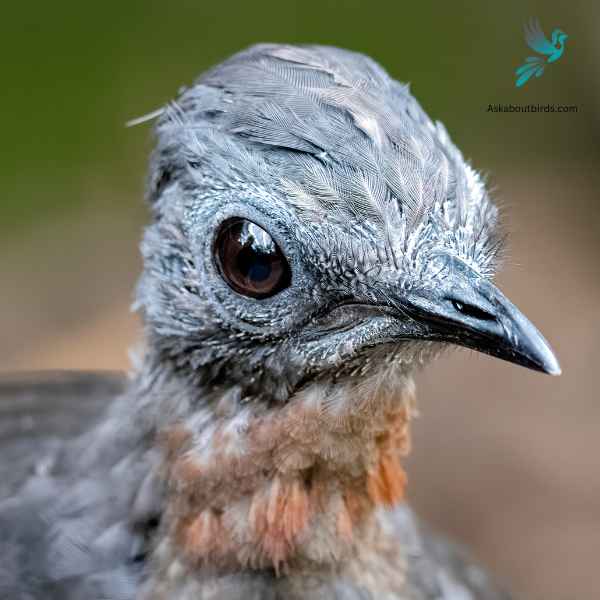
| Feature | Measurement |
|---|---|
| Scientific Name | Menura novaehollandiae |
| Length | 31-39 in |
| Wingspan | 27–31 in |
| Weight | 800 to 1,000 g |
The Superb Lyrebird is renowned for its exceptional mimicry abilities and intricate courtship display, primarily found in the rainforests of southeastern Australia.
Appearance: Superb Lyrebirds possess a neutral-colored plumage. Males are distinguished by their ornate tail feathers, which when fanned out during displays resemble a lyre or a musical harp. These tail feathers consist of two outermost lyre-shaped feathers, two broader guard feathers, and 12 fine filamentary feathers. Females are smaller and lack the pronounced tail features of the males.
Diet: These birds are omnivorous, feeding mainly on the forest floor. Their diet consists of invertebrates like insects, spiders, and worms, as well as seeds and small fruits.
Reproduction: Males construct and maintain impressive mounds of earth and debris, called display platforms, which they use to perform their elaborate song and dance routines. Their mimicry talent is showcased during these displays, as they imitate chainsaws, camera shutters, car alarms, and even other bird species. Females are lured by the quality of these performances.
Herring Gull
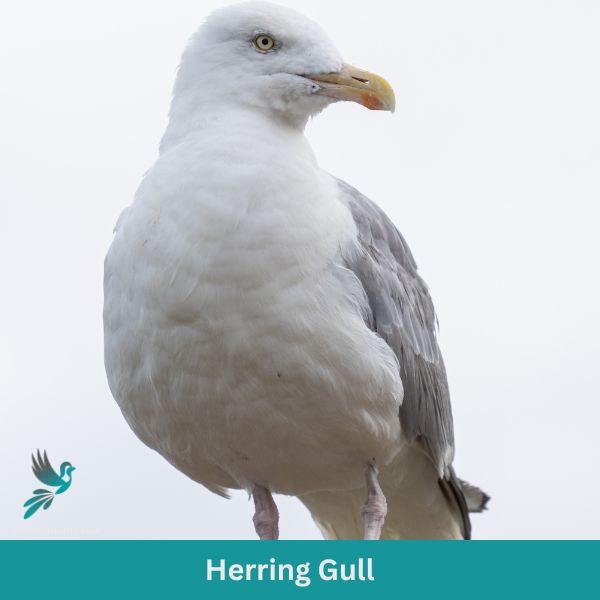
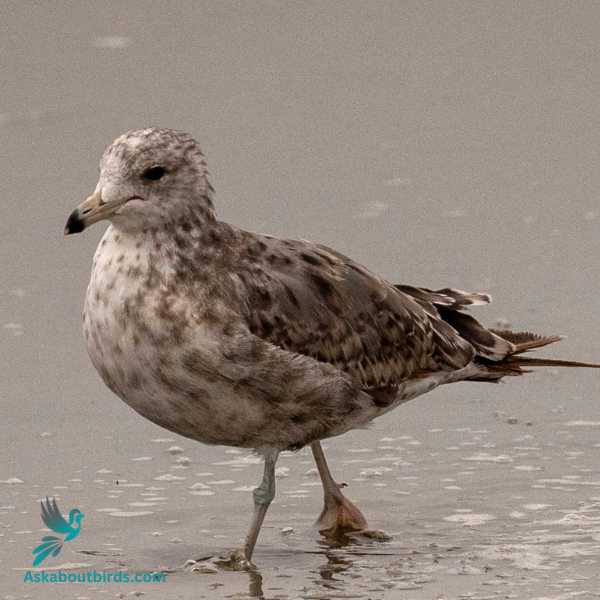
| Attribute | Information |
|---|---|
| Scientific Name | Larus argentatus |
| Length | 22-26 inches |
| Wingspan | 54-58 inches |
| Weight | 1.1-2.3 pounds |
The Herring Gull is a familiar sight along coasts and inland waters, known for its characteristic calls and widespread presence.
Appearance: Herring Gulls are predominantly white with gray wings and a distinct black band at the tip of each wing. Their eyes are pale yellow, complemented by a yellow bill that sports a notable red dot on the lower mandible.
Diet: These gulls are true opportunists when it comes to feeding. They enjoy a diet that spans from fish and marine invertebrates to insects and discarded human food. Their renowned scavenging habits are evident in public areas, making them a common sight at beaches, parks, and dumps.
Reproduction: Preferring to form nesting colonies, Herring Gulls establish their homes on the ground or atop sea-facing cliffs. Their nests, simple yet functional, are constructed from grass, twigs, and other available materials. A female typically lays a clutch of 2 to 4 eggs.
European Starling
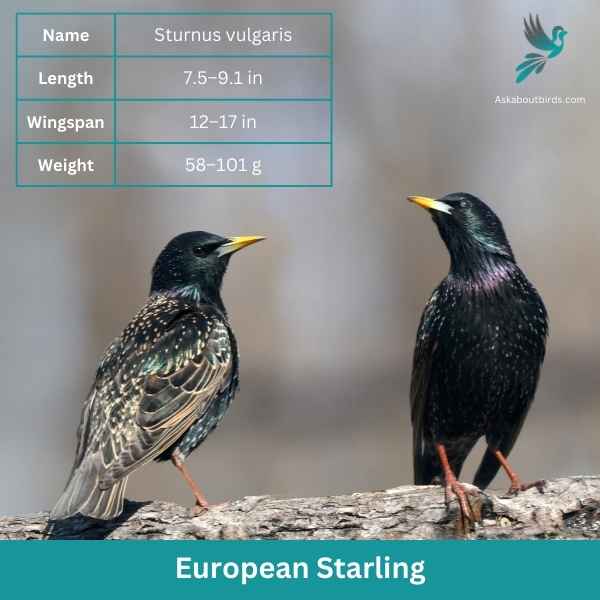

| Feature | Measurement |
|---|---|
| Scientific Name | Sturnus vulgaris |
| Length | 7.5–9.1 in |
| Wingspan | 12–17 in |
| Weight | 58–101 g |
The European Starling is a highly adaptable bird, recognized for its iridescent plumage and uncanny ability to mimic a variety of sounds, from other birds to mechanical noises.
Appearance: European Starlings showcase glossy black feathers with a purple or green sheen, especially prominent during the breeding season. Their winter plumage is speckled with white dots. Both males and females have a similar appearance, but juveniles are gray-brown overall until their first winter.
Diet: These birds are omnivorous, consuming a wide range of foods. Their diet includes insects, seeds, fruits, and occasionally even small vertebrates. European Starlings are known to forage in groups, often seen probing the ground with their strong, pointed bills.
Reproduction: European Starlings are cavity nesters, selecting sites such as holes in trees, buildings, or other structures. After a courtship display that involves singing and wing-flapping, the female lays a clutch of about 4 to 6 eggs
Pied Currawong
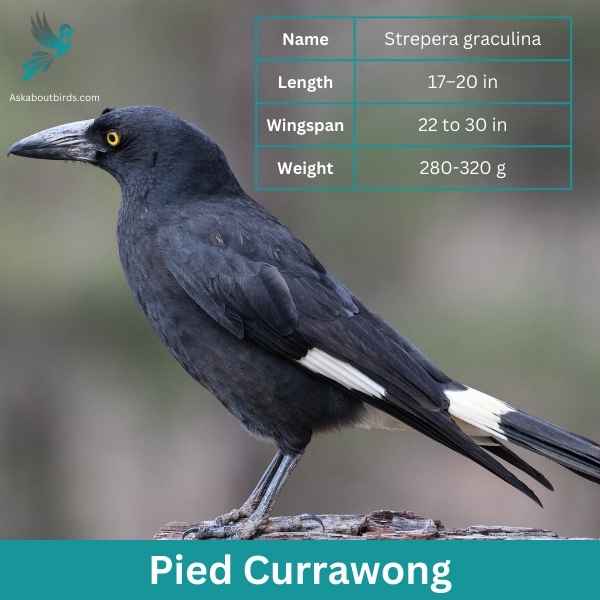
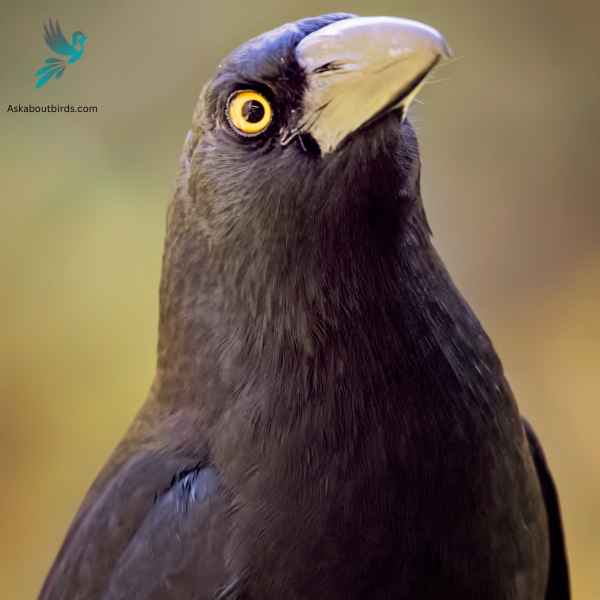
| Feature | Measurement |
|---|---|
| Scientific Name | Strepera graculina |
| Length | 17–20 in |
| Wingspan | 22 to 30 in |
| Weight | 280-320 g |
The Pied Currawong is a prominent bird native to eastern Australia, recognizable for its melodic calls and contrasting plumage.
Appearance: The Pied Currawong has a predominantly glossy black plumage, with noticeable white patches on the underparts, the base of the tail, and the tips of the wing feathers. Its bright yellow eyes add to its striking appearance.
Diet: These birds are omnivorous, feeding on a variety of foods. Their diet mainly consists of fruits, insects, and small vertebrates, including small birds and their chicks.
Reproduction: Pied Currawongs are known to nest in tall trees. The female typically lays a clutch of 3 to 4 eggs, which are incubated for around three weeks. The young are then cared for by both parents.
Reasons Behind the Attraction To A Shiny Object
The reasons behind this attraction are not entirely clear, but there are some theories that attempt to explain it.
One theory is that birds are attracted to shiny objects because they resemble sources of food. For example, aluminum cans or tin foil may resemble the scales of fish, which are a common food source for many bird species. Similarly, keys, coins, and other metallic objects may resemble insects or seeds that birds feed on.
Another theory is that birds are attracted to reflective objects. Mirrors, for example, can create flashes of light that catch a bird’s eye, and this may be particularly attractive to birds that have a strong sense of vision. Reflective surfaces, such as glass or water, may also create interesting patterns of light that birds find appealing.
Some researchers believe that birds may be attracted to shiny objects because they resemble valuable materials that are used in nest-building for bird nests. For example, trinkets, bells, and other shiny objects may resemble freshwater pearls, shells, or rocks, which are often used by birds to build nests. The smooth texture and glossy appearance of these materials may make them particularly attractive to birds.
Indeed, the popular belief that magpies are irresistibly attracted to shiny things has been debunked by scientific research, as you pointed out. The study conducted at Exeter University showed that magpies, contrary to the common myth, don’t necessarily prefer shiny items. In the experiment, they often showed caution towards unfamiliar shiny materials and opted for the blue objects instead.
While folklore and stories may depict magpies as collectors of shiny treasures, this particular scientific investigation contradicts that notion. Like many birds in the corvid family, which includes jays and crows, magpies are highly intelligent and curious. While they might investigate or interact with a variety of objects in their environment, it’s not accurate to say they have a specific preference for shiny objects over other items.
Instead, their behavior is more indicative of a general curiosity about the world around them rather than a fixation on shiny things. So, if you’re having a picnic, it might be wise to guard your food rather than your jewelry when these clever birds are around!
Regardless of the reasons behind our feathered friends attraction, it is important to note that not all bird species react the same way towards shiny stuff. Some birds, such as crows and magpies (hence the nickname the thieving magpie), are notorious for stealing shiny items such as jewelry or coins, while other birds show little interest at all – the more intelligent birds are more likely to be hoarders.
Frequently Asked Questions
What bird species are known for collecting small shiny objects?
Several wild birds are known for collecting shiny objects and shiny stones. Magpies, for example, are notorious for their attraction to shiny objects such as coins, jewelry, and even tin foil. Crows and ravens are also known to collect shiny objects, as well as scrub jays and blue jays.
How do birds incorporate shiny objects into their nests or homes?
Birds may incorporate shiny objects into their nests or homes as a form of decoration or to attract a mate. For example, male bowerbirds are known for building elaborate nests decorated with shiny objects such as shells and feathers to attract a female mate. Additionally, some bird species may use shiny objects as a form of camouflage, incorporating them into their nests to blend in with their surroundings.
Which seagull is attracted to shiny things?
The attraction to shiny objects is a behavior often attributed to many species of birds, including various types of gulls. Among seagulls, it is not limited to a particular species; many gulls display this behavior. The reasoning behind their attraction can be multifaceted:
- Shiny objects might resemble fish scales or the shimmer of water, both of which are linked to food.
- Birds, including gulls, are curious creatures and might be attracted to unusual or standout objects in their environment.




